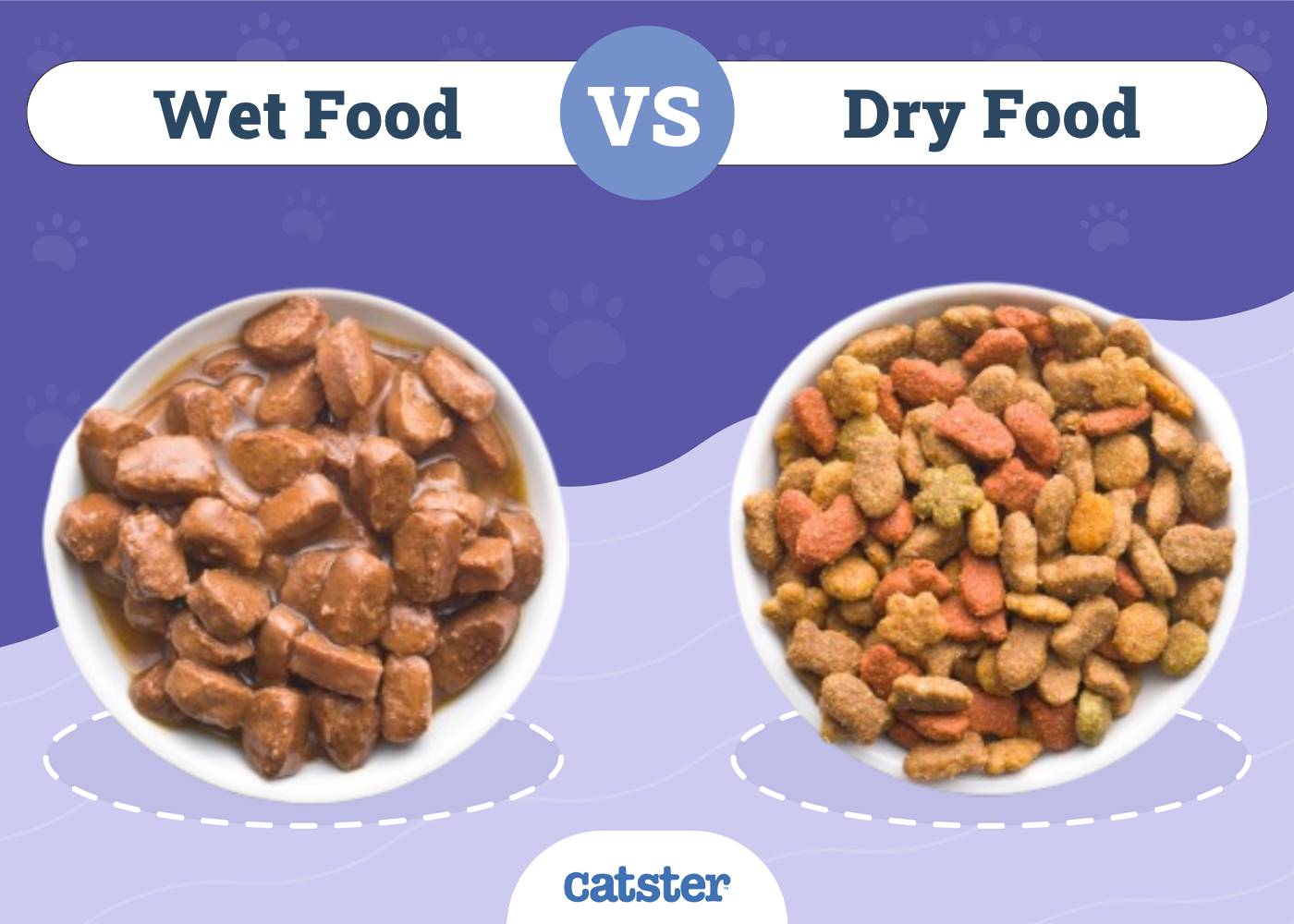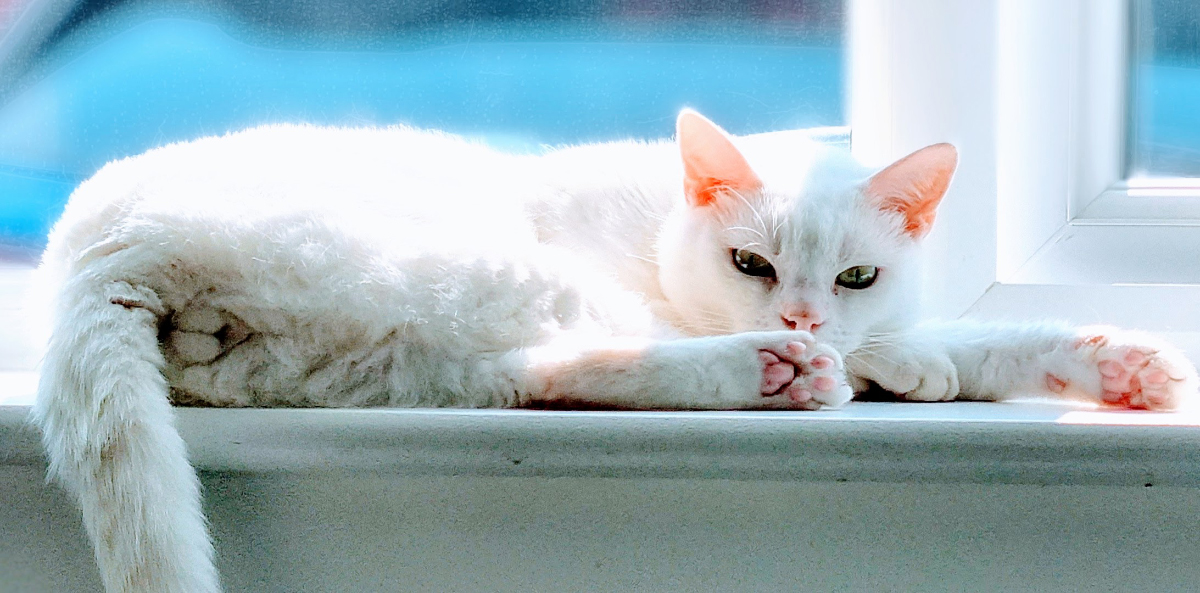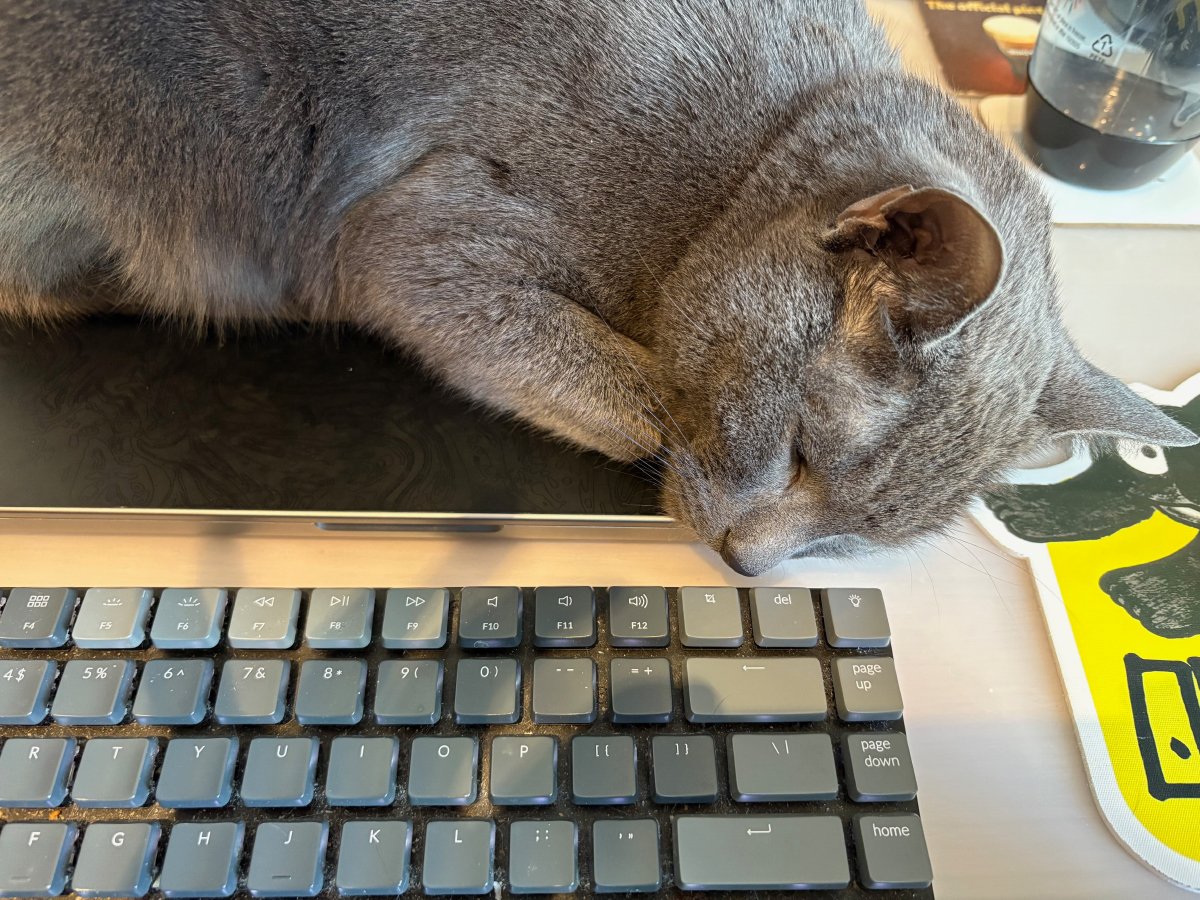Kirkland Signature Cat Food Review Summary
We give Kirkland Signature cat food a rating of 3.5 out of 5.0 stars.
Home to bulk bargain buys, Costco provides the ultimate warehouse shopping experience. And often you can find some of the best brand name goods and groceries for a great price. Costco also has its signature line—Kirkland Signature—which is considered by many to be the quintessential generic store brand.
And the Kirkland Signature brand isn’t just limited to your groceries. They make tons of different products including cat food. But just how good is it?
Today, we take an in-depth look into each recipe Kirkland Signature has to offer, so you can make the best choice for your cat.

At a Glance: The Best Kirkland Signature Cat Food Recipes:
| Image | Product | Details | |
|---|---|---|---|
Our favorite
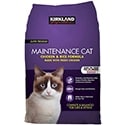
|
Kirkland Signature Chicken and Rice |
|
CHECK PRICE |

|
Kirkland Signature Nature’s Domain |
|
CHECK PRICE |

|
Kirkland Signature Healthy Weight |
|
CHECK PRICE |

Kirkland Signature Cat Food Reviewed
Before we jump into some individual product reviews, let’s talk a bit about Costco’s Kirkland Signature brand as a whole organization and whether their goods are suited for your furry loved ones.
Who Makes Kirkland Signature and Where Is It Produced?
Kirkland Signature is the premier store brand of Costco. And while Costco has some other smaller-scale generic brands, Kirkland Signature is the only one that makes cat food.
The actual cat food formulas are developed by Diamond Pet Foods, a powerhouse in the pet food arena. Diamond makes food for several well-known brands including Taste of the Wild, Chicken Soup for the Soul, 4health, and their own signature line Diamond.
These foods are all manufactured in one of five plants positioned around the United States. However, the ingredients for each Kirkland Signature blend may be acquired from places outside of the US.
Which Types of Cats Is Kirkland Signature Cat Food Best Suited For?
If you’re seeking a standard run-of-the-mill cat food, Costco’s Kirkland Signature may be a viable option for you. It’s reasonably priced and provides all of the basic nutrition that your cat needs to live a happy, healthy life.
Which Types of Pets Might Do Better with a Different Brand?
However, if your cat has special dietary needs, you may want to search elsewhere for their food. Kirkland Signature doesn’t offer much in the way of variety with only three different recipes in their entire cat food line—all dry kibble.
Felines requiring a more protein-enriched diet should also steer clear of Costco’s cat food. Not to say there’s no protein, but it is a little lacking when it comes to protein content percentage with the highest being 32% among the available choices.

Discussion of the Primary Ingredients in Kirkland Signature Cat Food
When it comes to their ingredient lists, the Kirkland brand cat foods are relatively straightforward and easy to read. There’s nothing out of place or overly concerning. We really like that the number one ingredient is a protein source for each formula. That, and the fact that there are no wheat, soy, or corn products to be found.
There are other rice filler ingredients, though, including ground white rice and whole-grain brown rice. And when compared to other potential fillers and grains, the rice—especially the brown rice—shows little cause for concern.
When it comes down to directly comparing the ingredient lists between the three, the Nature’s Domain variety is easily the top pick. With no grains at all, healthy complex carbohydrates are provided via sweet potatoes and potatoes. There’s also a whole bunch of other fruits and vegetables incorporated.
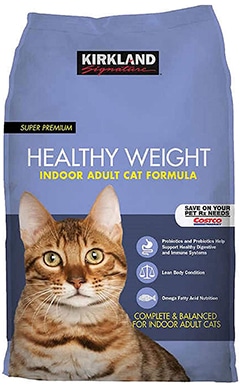
Kirkland Signature Cat Food Nutritional Info
As far as overall nutrition is concerned, Kirkland Signature cat food blends will be able to fully supply everything your cat needs to live a happy, healthy life. However, it’s still not among the most nutritious available on the market.
In order to cut costs and bring you big savings, premium ingredients are kept to a minimum. This prevents Kirkland Signature cat food formulas from pushing the envelope in terms of nutrition. The protein percentages for each blend are just slightly below the industry average. And there’s only one recipe that can be considered a low-fat option.
Feeding your cat a high-quality diet is important for keeping them healthy and happy. But it goes beyond the food you choose; the dishes they use also matter. The Hepper NomNom Cat Bowl is our favorite for its unique, five-star design that protects from whisker fatigue and promotes good posture which also aids in better digestion. As an added bonus, it’s beautifully crafted and offers a modern take on the traditional cat bowl that fits seamlessly with all home stylings. Learn more about the NomNom by clicking here. At Catster, we’ve admired Hepper for many years and decided to take a controlling ownership interest so that we could benefit from the outstanding designs of this cool cat company!
Kirkland Signature Cat Food Lines
When it comes to different availabilities, Kirkland only has three separate recipes of cat food. Each of these is a dry kibble variety. Previously, Costco released two wet food variations under the Kirkland name, but they have since been discontinued.
- Super Premium Maintenance Cat: This is Kirkland Signature’s catch-all cat food blend. It’s designed to be an effective source of nutrition for felines of all ages from kittens to aging seniors.
- Nature’s Domain: If you’re looking for the most premium Kirkland Signature cat food formula, Nature’s Domain is it. It’s Costco’s grain-free option and has the highest protein content of the three. The formula also contains other higher-end ingredients such as blueberries and sweet potato for better nutrition and carbohydrate sources.
- Healthy Weight: Are you noticing that your fur baby is getting just a bit big? It may be time for them to go on a diet. You can do so affordably by swapping over to Kirkland Signature Healthy Weight. It’s the only low-fat option of the bunch, coming in at a 9% crude fat percentage.

A Quick Look at Kirkland Signature Cat Food
- Whole protein is always the number one ingredient
- Affordable
- Each blend can provide 100% of your cat’s nutritional needs
- No corn, wheat, or soy byproducts
- Ground white rice is in 2 out of 3 recipes
- No real standout advantages other than cost

Recall History of Kirkland Signature Cat Food
Finding out your cat’s favorite food has been recalled can be a scary experience. After all, the food they eat should be nourishing and fulfilling—not dangerous. But most cat foods have been recalled at some point in time or another. And that holds true with the Kirkland Signature brand.
In early 2012, a recall was issued for Kirkland Signature brand cat food due to potential Salmonella contamination concerns. However, this contamination wasn’t just for Kirkland. All Diamond-produced foods and brands were suspected of possible taint. This included Chicken Soup for the Soul, Diamond, Taste of the Wild, 4Health, Premium Edge, and Country Value.
As a result of a thorough FDA investigation, the main source of this contamination was narrowed to Diamond’s processing facilities in Gaston, South Carolina. There, the investigators determined that Diamond wasn’t observing all reasonable precautions and following best practices to ensure the quality of their products.
This ultimately led to the safety recall of the Kirkland Signature brand cat food. What makes this recall so gut-wrenching, however, is that 2012 wasn’t the first FDA complaint to come out of the Gaston plant. In fact, seven years earlier in 2005, the manufacturer received a warning from the FDA for gross violations with severe levels of aflatoxin.
Fortunately, there have been no more incidents after the 2012 recall.

Reviews of the 3 Best Kirkland Signature Cat Food Recipes
With limited choices, there are not too many options that Kirkland Signature has to offer. However, that doesn’t mean that they aren’t the right choice for your cat. Here are reviews of the three recipes they have to offer:
1. Kirkland Signature Maintenance Cat Chicken and Rice Formula (All Life Stages)
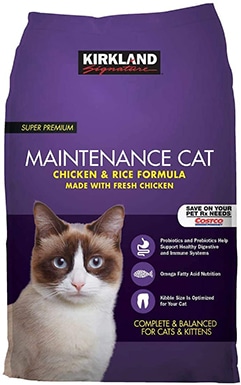
If you’re looking for an affordable cat food that you can buy in bulk, Kirkland Signature’s Maintenance Cat might be right up your alley. It’s Costco’s standard cat food. While it may not specifically cater to any special dietary needs, this cat food can be utilized across all life stages, from their time as a kitten to their golden years as a senior.
It doesn’t have the highest protein content or lowest fat count, but it will provide everything your furball needs to be healthy.
Guaranteed Analysis:
| Crude Protein: | 30% |
| Crude Fat: | 20% |
| Moisture: | 10% |
| Fibre | 3% |
| Omega 6 Fatty Acids: | 3.3% |
- Great for cats of all ages
- Made in the USA
- Affordable
- Contains two varieties of rice
2. Kirkland Signature Nature’s Domain Salmon Meal and Sweet Potato Recipe Cat Food

Nature’s Domain is Kirkland’s grain-free offering and is best for cats who have allergies to wheat, soy, or corn. Instead of rice, Nature’s Domain provides complex carbs through the use of sweet potatoes and potatoes. It also has the highest protein percentage of the three Kirkland selections weighing in at 32%. While the most protein-rich of the Costco recipes, it’s still barely at industry standard.
This blend is also the most expensive of the three. And it just doesn’t seem like a fully feasible option if you’re looking for a premium cat food. There are other brands available that are a much better value for what you’re seeking.
Guaranteed Analysis:
| Crude Protein: | 32% |
| Crude Fat: | 14% |
| Moisture: | 10% |
| Fibre | 3% |
| Omega 6 Fatty Acids: | 2.4% |
- Highest protein content of the Kirkland Signature varieties
- Grain-free
- Better deals across brands for premium cat food
- Doesn’t provide the desired nutrition for a grain-free formula
3. Kirkland Signature Healthy Weight Indoor Adult Cat Formula

Is your cat putting on a bit too much weight? They may need to go on a diet. Kirkland Signature’s Healthy Weight could be a viable solution. As the only low-fat option Costco’s flagship provides, you can help to regulate the amount of crude fat in your cat’s diet by feeding them this recipe.
Stereotypically, low-fat cast foods are full of filler carbs or other materials to make up for the lack of crude fat. However, this Kirkland Signature selection only utilizes ground white rice and potato protein to get the job done.
Guaranteed Analysis:
| Crude Protein: | 32% |
| Crude Fat: | 9% |
| Moisture: | 10% |
| Fibre | 10% |
| Omega 6 Fatty Acids: | 1.7% |
- Low crude fat percentage at 9%
- Added omega-3 and omega-6 fatty acids
- No corn, wheat, or soy ingredients
- Not suitable for cats with rice sensitivities

What Other Users Are Saying About Kirkland Signature Cat Food
We’ve looked at some other reviews for you to take a look at to help you better decide if Kirkland Signature is the right brand for your loved one.
- From Christina on Costco – “I’ve been using this cat food for a while now. I used to buy cat food from specialty stores for $50/bag and then I decided to give this a shot because of the price. My cats liked it and I thought, okay I guess I can keep this for a while. Later, when my husband’s cat came into the picture, she switched to Kirkland and also liked it. What I really want to emphasize is that I have seen a noticeable improvement in my husband’s cat’s fur. She is a black cat so if she has dandruff it’s very visible and after switching to this cat food, her skin/fur has no dandruff and her fur feels much better.”
- From Tonya on Influenster – “I have four cats, so I have to buy cat food in bulk. It took a while to find a food that everybody likes. So when I finally tried this Kirkland product at Costco and brought it home, they all loved it. It’s a great price, it’s great value and it’s a great brand.”
- Amazon – As pet owners, we always like to have a glance at Amazon reviews from buyers before we make a purchase.

Conclusion
Kirkland Signature cat food might not be the most nutritious available for your cat, but it’s not terrible by any means. Each recipe can still easily provide all of the daily intake your cat needs and do so without breaking the bank.
And if you’re looking to buy cat food in bulk, there is no better deal than Kirkland Signature blends.
See also:
Contents
- Kirkland Signature Cat Food Review Summary
- At a Glance: The Best Kirkland Signature Cat Food Recipes:
- Kirkland Signature Cat Food Reviewed
- Who Makes Kirkland Signature and Where Is It Produced?
- Which Types of Cats Is Kirkland Signature Cat Food Best Suited For?
- Which Types of Pets Might Do Better with a Different Brand?
- Discussion of the Primary Ingredients in Kirkland Signature Cat Food
- Kirkland Signature Cat Food Nutritional Info
- Kirkland Signature Cat Food Lines
- A Quick Look at Kirkland Signature Cat Food
- Recall History of Kirkland Signature Cat Food
- Reviews of the 3 Best Kirkland Signature Cat Food Recipes




